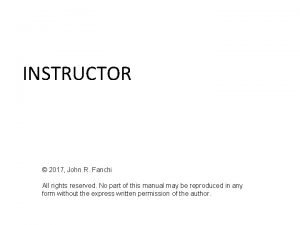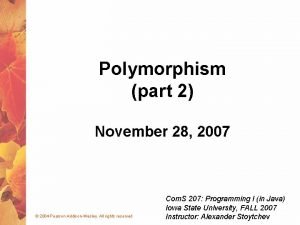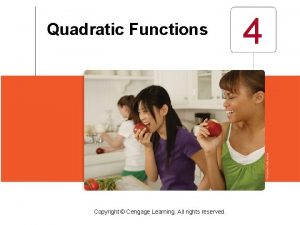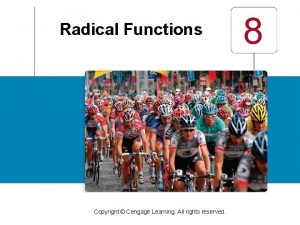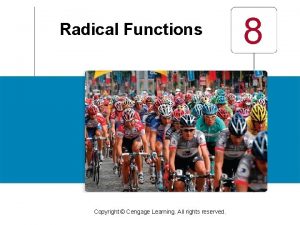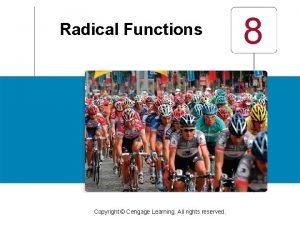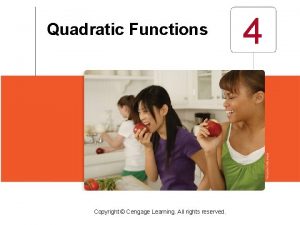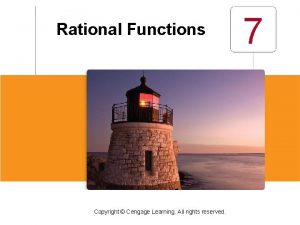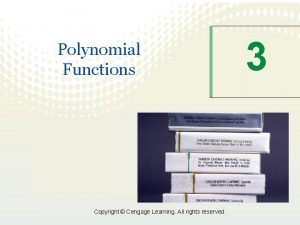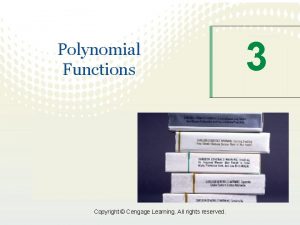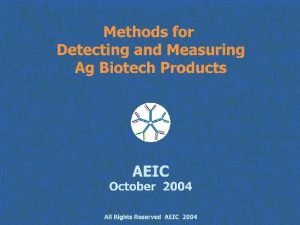2 Functions Copyright Cengage Learning All rights reserved








































- Slides: 40

2 Functions Copyright © Cengage Learning. All rights reserved.

2. 1 Functions Copyright © Cengage Learning. All rights reserved.

Objectives ■ Functions All Around Us ■ Definition of Function ■ Evaluating a Function ■ The Domain of a Function ■ Four Ways to Represent a Function 3

Functions All Around Us 4

Functions All Around Us In nearly every physical phenomenon we observe that one quantity depends on another. For example, your height depends on your age, the temperature depends on the date, the cost of mailing a package depends on its weight (see Figure 1). Height is a function of age. Temperature is a function of date. Postage is a function of weight. Figure 1 5

Functions All Around Us We use the term function to describe this dependence of one quantity on another. That is, we say the following: § Height is a function of age. § Temperature is a function of date. § Cost of mailing a package is a function of weight. 6

Functions All Around Us Here are some more examples: § The area of a circle is a function of its radius. § The number of bacteria in a culture is a function of time. § The weight of an astronaut is a function of her elevation. § The price of a commodity is a function of the demand for that commodity. 7

Functions All Around Us The rule that describes how the area A of a circle depends on its radius r is given by the formula A = r 2. Even when a precise rule or formula describing a function is not available, we can still describe the function by a graph. For example, when you turn on a hot water faucet, the temperature of the water depends on how long the water has been running. So we can say: § The temperature of water from the faucet is a function of time. 8

Definition of Function 9

Definition of Function A function is a rule. To talk about a function, we need to give it a name. We will use letters such as f, g, h, . . . to represent functions. For example, we can use the letter f to represent a rule as follows: “ f ” is the rule “square the number” 10

Definition of Function We usually consider functions for which the sets A and B are sets of real numbers. The symbol f (x) is read “f of x” or “f at x” and is called the value of f at x, or the image of x under f. The set A is called the domain of the function. The range of f is the set of all possible values of f (x) as x varies throughout the domain, that is, range of f = {f (x) | x A} 11

Definition of Function The symbol that represents an arbitrary number in the domain of a function f is called an independent variable. The symbol that represents a number in the range of f is called a dependent variable. So if we write y = f (x), then x is the independent variable and y is the dependent variable. 12

Definition of Function It is helpful to think of a function as a machine (see Figure 3). Machine diagram of f Figure 3 If x is in the domain of the function f, then when x enters the machine, it is accepted as an input and the machine produces an output f (x) according to the rule of the function. 13

Definition of Function Thus we can think of the domain as the set of all possible inputs and the range as the set of all possible outputs. Another way to picture a function f is by an arrow diagram as in Figure 4(a). Arrow diagram Figure 4 14

Definition of Function Each arrow associates an input from A to the corresponding output in B. Since a function associates exactly one output to each input, the diagram in Figure 4(a) represents a function but the diagram in Figure 4(b) does not represent a function. Arrow diagrams Figure 4 15

Example 1 – Analyzing a Function A function f is defined by the formula f (x) = x 2 + 4 (a) Express in words how f acts on the input x to produce the output f (x). (b) Evaluate f (3), f (– 2), and f ( ). (c) Find the domain and range of f. (d) Draw a machine diagram for f. 16

Example 1 – Solution (a) The formula tells us that f first squares the input x and then adds 4 to the result. So f is the function “square, then add 4” (b) The values of f are found by substituting for x in the formula f (x) = x 2 + 4. f (3) = 32 + 4 = 13 Replace x by 3 f (– 2) = (– 2)2 + 4 = 8 Replace x by – 2 f( )=( )2 + 4 = 9 Replace x by 17

Example 1 – Solution cont’d (c) The domain of f consists of all possible inputs for f. Since we can evaluate the formula f (x) = x 2 + 4 for every real number x, the domain of f is the set of all real numbers. The range of f consists of all possible outputs of f. Because x 2 0 for all real numbers x, we have x 2 + 4 4, so for every output of f we have f (x) 4. Thus, the range of f is {y | y 4} = [4, ). 18

Example 1 – Solution cont’d (d) A machine diagram for f is shown in Figure 5. Machine diagram Figure 5 19

Evaluating a Function 20

Evaluating a Function In the definition of a function the independent variable x plays the role of a placeholder. For example, the function f (x) = 3 x 2 + x – 5 can be thought of as To evaluate f at a number, we substitute the number for the placeholder. 21

Example 2 – Evaluating a Function Let f (x) = 3 x 2 + x – 5. Evaluate each function value. (a) f (– 2) (b) f (0) (c) f (4) (d) f ( ) Solution : To evaluate f at a number, we substitute the number for x in the definition of f. (a) f(– 2) = 3 (– 2)2 + (– 2) – 5 =5 22

Example 2 – Solution cont’d (b) f (0) = 3 02 + 0 – 5 = – 5 (c) f (4) = 3 (4)2 + 4 – 5 = 47 (d) f ( ) = 3 ( )2 + – 5 = 23

Evaluating a Function From Examples 2 we see that the values of a function can change from one input to another. The net change in the value of a function f as the input changes from a to b (where a b) is given by 24

The Domain of a Function 25

The Domain of a Function We know that the domain of a function is the set of all inputs for the function. The domain of a function may be stated explicitly. For example, if we write f (x) = x 2 0 x 5 then the domain is the set of all real numbers x for which 0 x 5. 26

The Domain of a Function If the function is given by an algebraic expression and the domain is not stated explicitly, then by convention the domain of the function is the domain of the algebraic expression—that is, the set of all real numbers for which the expression is defined as a real number. For example, consider the functions The function f is not defined at x = 4, so its domain is {x | x ≠ 4}. The function g is not defined for negative x, so its domain is {x | x 0}. 27

Example 7 – Finding Domains of Functions Find the domain of each function. Solution: (a) A rational expression is not defined when the denominator is 0. Since we see that f (x) is not defined when x = 0 or x = 1. 28

Example 7 – Solution cont’d Thus, the domain of f is { x | x ≠ 0, x ≠ 1} The domain may also be written in interval notation as ( , 0) (0, 1) (1, ) (b) We can’t take the square root of a negative number, so we must have 9 – x 2 0. We can solve this inequality to find that – 3 x 3. Thus the domain of g is {x | – 3 x 3} = [– 3, 3] 29

Example 7 – Solution cont’d (c) We can’t take the square root of a negative number, and we can’t divide by 0, so we must have t + 1 > 0, that is, t > – 1. So the domain of h is {t | t > – 1} = (– 1, ) 30

Four Ways to Represent a Function 31

Four Ways to Represent a Function To help us understand what a function is, we have used machine and arrow diagrams. We can describe a specific function in the following four ways: § verbally (by a description in words) § algebraically (by an explicit formula) § visually (by a graph) § numerically (by a table of values) 32

Four Ways to Represent a Function A single function may be represented in all four ways, and it is often useful to go from one representation to another to gain insight into the function. However, certain functions are described more naturally by one method than by the others. 33

Four Ways to Represent a Function An example of a verbal description is the following rule for converting between temperature scales: “To find the Fahrenheit equivalent of a Celsius temperature, multiply the Celsius temperature by then add 32. ” In Example 8 we see how to describe this verbal rule or function algebraically, graphically, and numerically. 34

Four Ways to Represent a Function A useful representation of the area of a circle as a function of its radius is the algebraic formula A (r) = r 2 The graph produced by a seismograph is a visual representation of the vertical acceleration function a (t) of the ground during an earthquake. As a final example, consider the function C (w), which is described verbally as “the cost of mailing a large first-class letter with weight w. ” 35

Four Ways to Represent a Function The most convenient way of describing this function is numerically—that is, using a table of values. 36

Four Ways to Represent a Function We summarize the four representations of a function in the following box. 37

Example 8 – Representing a Function Verbally, Algebraically, Numerically, and Graphically Let F (C) be the Fahrenheit temperature corresponding to the Celsius temperature C. (Thus F is the function that converts Celsius inputs to Fahrenheit outputs. ) The previous box of “Four ways to represent a function”, gives a verbal description of this function. Find ways to represent this function (a) Algebraically (using a formula) (b) Numerically (using a table of values) (c) Visually (using a graph) 38

Example 8 – Solution (a) The verbal description tells us that we should first multiply the input C by and then add 32 to the result. So we get F(C) = C + 32 (b) We use the algebraic formula for F that we found in part (a) to construct a table of values: 39

Example 8 – Solution cont’d (c) We use the points tabulated in part (b) to help us draw the graph of this function in Figure 6. Celsius and Fahrenheit Figure 6 40
 Copyright 2015 all rights reserved
Copyright 2015 all rights reserved Copyright © 2015 all rights reserved
Copyright © 2015 all rights reserved Dell all rights reserved copyright 2009
Dell all rights reserved copyright 2009 Copyright © 2018 all rights reserved
Copyright © 2018 all rights reserved Copyright cengage learning. powered by cognero
Copyright cengage learning. powered by cognero All rights reserved example
All rights reserved example All rights reserved sentence
All rights reserved sentence Freesound content licence
Freesound content licence Confidential all rights reserved
Confidential all rights reserved Sentinel-controlled repetition
Sentinel-controlled repetition Pearson education inc all rights reserved
Pearson education inc all rights reserved Microsoft corporation. all rights reserved.
Microsoft corporation. all rights reserved. Microsoft corporation. all rights reserved.
Microsoft corporation. all rights reserved. Microsoft corporation. all rights reserved.
Microsoft corporation. all rights reserved. Pearson education inc. all rights reserved
Pearson education inc. all rights reserved Warning all rights reserved
Warning all rights reserved Siprop
Siprop Quadratic equation cengage
Quadratic equation cengage Warning all rights reserved
Warning all rights reserved Confidential all rights reserved
Confidential all rights reserved Microsoft corporation. all rights reserved
Microsoft corporation. all rights reserved 2010 pearson education inc
2010 pearson education inc 2017 all rights reserved
2017 all rights reserved Copyright 2010 pearson education inc
Copyright 2010 pearson education inc Pearson education inc. all rights reserved
Pearson education inc. all rights reserved Confidential all rights reserved
Confidential all rights reserved Airbus deutschland gmbh
Airbus deutschland gmbh R rights reserved
R rights reserved Rights reserved
Rights reserved Delmar cengage learning medical terminology
Delmar cengage learning medical terminology Chapter 5 the cardiovascular system labeling exercises
Chapter 5 the cardiovascular system labeling exercises Cengage learning heart diagram
Cengage learning heart diagram South-western cengage learning
South-western cengage learning 2009 delmar cengage learning
2009 delmar cengage learning 2009 delmar cengage learning
2009 delmar cengage learning Cengage learning heart diagram
Cengage learning heart diagram Introduction to medical terminology chapter 1
Introduction to medical terminology chapter 1 Cengage learning australia
Cengage learning australia Graphing tpr
Graphing tpr Cengage learning
Cengage learning Cengage learning
Cengage learning



























